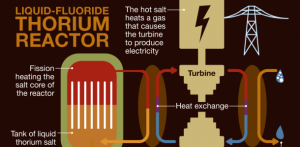Why Gregor is Wrong on Nuclear Energy
When it comes to commenting on the world energy situation, Gregor MacDonald stands out as exceptional. If you haven’t been following Gregor.US, you should put that on your regular reading list — especially if you are an investor. When I read his recent post on nuclear energy, however, his bottom line statement that “nuclear power will never rise to 10% of total global energy supply” simply couldn’t get past my econosystemics filter.
Gregor argues that despite coal being much more dangerous than nuclear, the public’s irrationality will always react more strongly against rare but spectacular nuclear accidents. Combine that irrational fear with the cold hard economic fact that coal energy is much cheaper than nuclear energy (externalities excluded), and nuclear doesn’t stand a chance.
In the short run, this is a very strong argument, and I wouldn’t advise making short-term financial bets against Gregor’s analysis. But if we take a longer run view, in which corporate interests dominate political decisions and exponentially improving technologies dominate the Technium, the energy density of nuclear will win out over digging coal, fracking for gas, or covering every possible surface with photovoltaics.
Exponential technological improvements will be applied to all energy sources, of course, as well as to energy efficiency. Solar energy harvesting, in particular, will become much cheaper and efficient. Energy storage and transmission also will improve, allowing us to better utilize the solar energy we collect. Robot mining and carbon sequestration could make “clean coal” more of a reality. But nuclear energy will always beat out everything else in terms of energy density. And here is the time-tested rule: Life, writ large, has never failed to exploit the highest density energy potentials it can crack open.
At present, coal and gas have more billionaires, and thus more political power, than does any alternative for electricity generation. But the Technium’s thirst for more energy is unslakeable. Not only do six billion people want to come up to the consumption zone of the top billion, but exponential technologies will demand exponentially more energy, even as they become exponentially more efficient. Just consider computer processing: while it has become millions of times more energy-efficient over time, total power consumption due to computing has simultaneously increased exponentially.
Coal and gas can’t keep up with that trend for more than another decade. Ray Kurtzweil is sanguine that solar will meet all our energy needs in 20 years, but I think he is underestimating exponential growth in energy demand, and the exponentially increasing surface areas solar will require. Nuclear, however, can provide an intense, steady energy gradient within a very small footprint, scalable to any conceivable demand. That’s what the Technium wants; and what the Technium wants, it finds a way to get.
Political power in the United States supposedly rests in a democratic social contract, a government of, by and for the people. In reality,however, democracy is at best only a safety valve for political control by the powerful. Public opinion is shaped by money flow and media control. The influence of billionaires and large corporations manipulates public opinion to serve their own competing interests. It is the society of corporations, not the society of voters, which will decide the fate of nuclear energy.
Here is what I think will play out in the next two decades. In the short term, competition among powerful corporations and individuals, and concerns over nuclear terrorism, will outweigh concerns over climate change and biodiversity collapse. Natural gas, temporarily plentiful and cheap, will be the ascendant energy source of the decade. Coal plants will continue to proliferate like bacteria on a forgotten pot of chicken soup.
But along about 2015, the balance will shift. New capabilities for compact, factory-sealed, rail-transportable nuclear cores will completely change the economics of building nuclear plants. A next-generation of thorium-based reactors will be in development. A few large thorium –or, potentially, fusion– reactors will be able to serve as “incinerators” consuming nuclear waste from other reactors, from weapons, and from other sources. Increasingly sophisticated global surveillance and response systems will help guard against nuclear weapons proliferation and terrorism (sorry, privacy advocates). The accelerating impacts of climate change and biodiversity will foster more international cooperation among the powerful. Around about 2015-2018, the society of corporations will reach a consensus: the Technium needs nuclear.
When the society of corporations, expressing the unconscious but irresistible will of the Technium, decides to pursue nuclear energy, you can be sure that public opinion will follow right along. Factory-style production and improved safety and security systems will enable an extremely rapid deployment over the decade following that. Modular will be used as “drop-in” replacements for aging coal plants, leveraging existing power distribution systems. Economies of scale will rapidly reduce costs of deployment.
Gregor says he’ll bet that nuclear never cracks 10% of total world energy supply. Kurtzweil says in 20 years solar will provide all of our energy supply. I say they are both wrong. I’ll bet that nuclear (fission and/or fusion) is 10% of world energy supply by 2025, and 50% by 2030.



Recent Comments